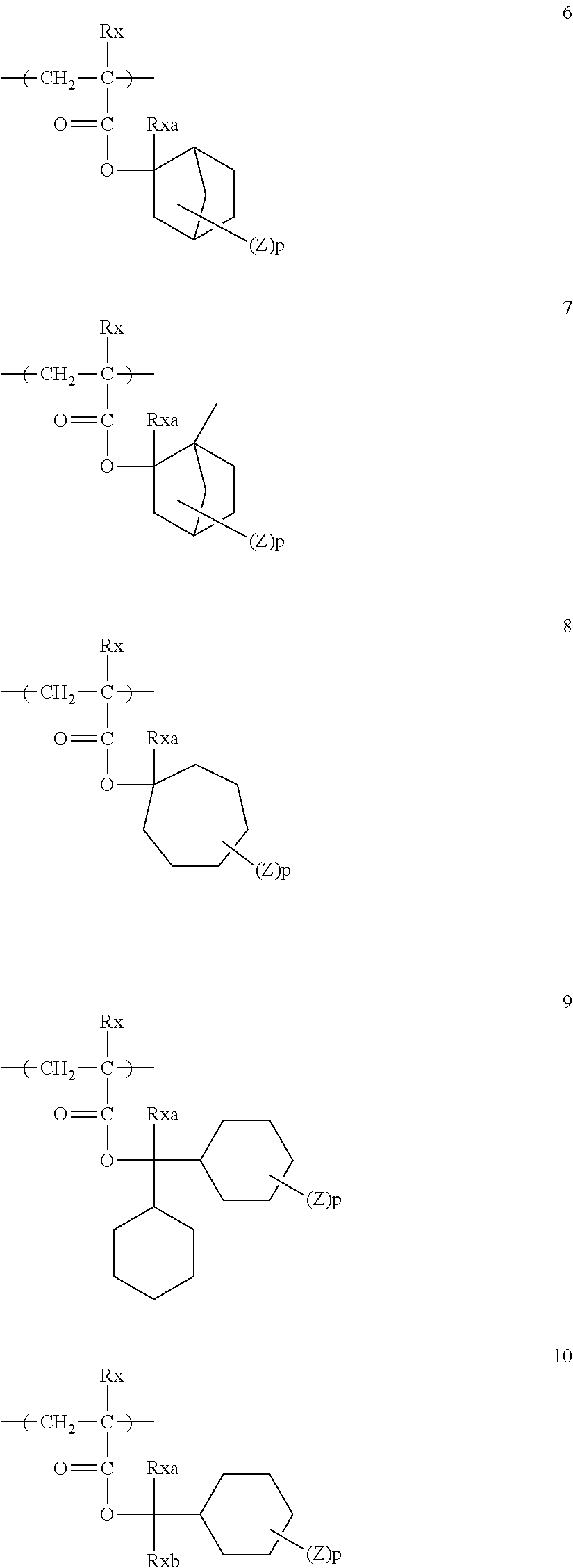Negative pattern forming method and resist pattern
- Summary
- Abstract
- Description
- Claims
- Application Information
AI Technical Summary
Benefits of technology
Problems solved by technology
Method used
Image
Examples
synthesis example 1
Synthesis of Resin (A)
Synthesis of Resin (A-1):
[0542]In a nitrogen stream, a three-neck flask was charged with 40 g of cyclohexanone and heated at 80° C. (Solvent 1). Monomers corresponding to the following repeating units were dissolved in cyclohexanone in a molar ratio of 30 / 10 / 50 / 10 to prepare a 22 mass % monomer solution (400 g), and polymerization initiator V-601 (produced by Wako Pure Chemical Industries, Ltd.) in a concentration of 7.2 mol % based on the monomers was added thereto and dissolved. The resulting solution was added dropwise to Solvent 1 over 6 hours. After the completion of dropwise addition, the reaction was further allowed to proceed at 80° C. for 2 hours. The reaction solution was left standing to cool and then poured in 3,600 ml of heptane / 400 ml of ethyl acetate, and the precipitated powder was collected by filtration and dried, as a result, 74 g of Resin (A-1) was obtained. The compositional ratio of the polymer determined from NMR was 30 / 10 / 50 / 10. Also, th...
synthesis example 2
Synthesis of Acid Generator (PAG-2)
[0546]Acid Generator (PAG-2) was synthesized in accordance with the description in paragraphs [0382] to [0385] of WO2008 / 153110A1.
[0547]Photoacid Generators (PAG-1) and (PAG-3) to (PAG-5) having the following structures were synthesized in the same manner.
[0548]The components shown in Table 2 below were dissolved in the solvent shown in Table 2, and the resulting solution was filtered through a polyethylene filter having a pore size of 0.03 μm to prepare Resist Compositions Ar-1 to Ar-13. In Table 2, the amount added is mass % based on the entire mass of the composition.
TABLE 2Resin (A)Acid Generator (B)Basic Compound (D)Surfactant (E)Solvent (C)AmountAmountAmountAmountCompo-AddedAddedAddedAddedMasssitionKind(mass %)Kind(mass %)Kind(mass %)Kind(mass %)KindRatioAr-1(A-1)8.3(PAG-1)0.5TPI0.1W-40.05Al / B160 / 40Ar-2(A-2)8.6(PAG-2)0.5DPA / TPI0.05 / 0.05W-10.05Al100Ar-3(A-3)8.0(PAG-5)1.3PEA0.1W-30.05Al / A290 / 10Ar-4(A-4) / (A-6)5.2 / 3.3(PAG-1)0.4——W-40.05Al / B170 / 30...
PUM
| Property | Measurement | Unit |
|---|---|---|
| Thickness | aaaaa | aaaaa |
| Height | aaaaa | aaaaa |
| Nanoscale particle size | aaaaa | aaaaa |
Abstract
Description
Claims
Application Information
 Login to View More
Login to View More - R&D
- Intellectual Property
- Life Sciences
- Materials
- Tech Scout
- Unparalleled Data Quality
- Higher Quality Content
- 60% Fewer Hallucinations
Browse by: Latest US Patents, China's latest patents, Technical Efficacy Thesaurus, Application Domain, Technology Topic, Popular Technical Reports.
© 2025 PatSnap. All rights reserved.Legal|Privacy policy|Modern Slavery Act Transparency Statement|Sitemap|About US| Contact US: help@patsnap.com



